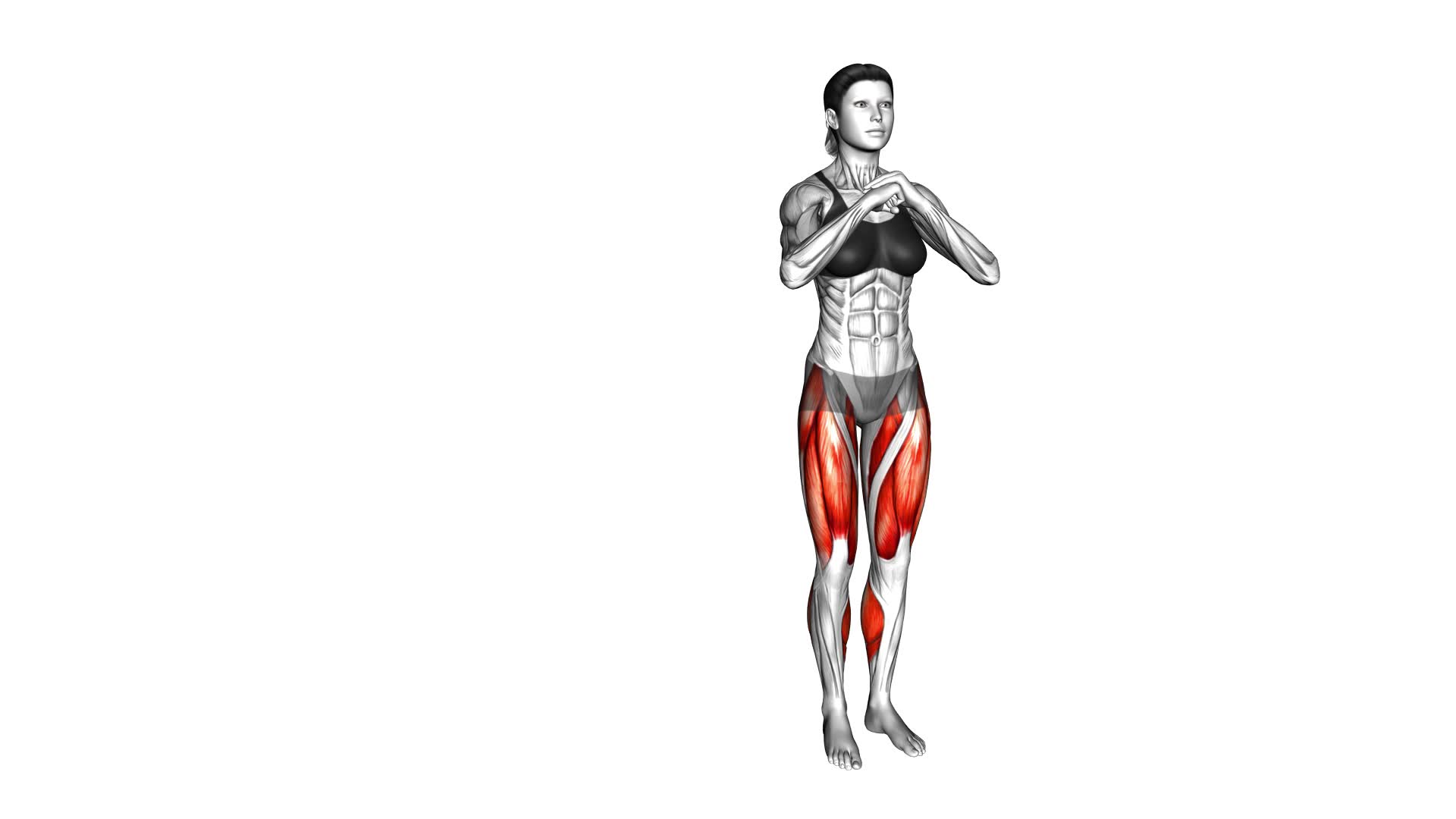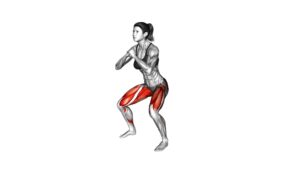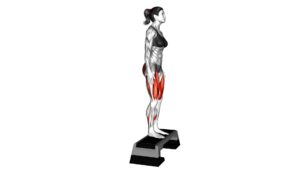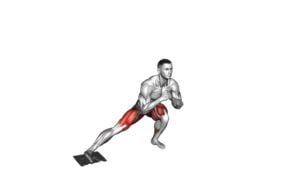Bodyweight Side Squat Step (female) – Video Exercise Guide & Tips

Are you looking for a challenging lower body exercise that targets your glutes and thighs? Look no further than the bodyweight side squat step.
Watch This Exercise Video
In this video exercise guide, we'll show you the proper form and technique to get the most out of this exercise. Whether you're a beginner or more advanced, we've got tips and variations to suit your fitness level.
Plus, we'll help you avoid common mistakes. Get ready to feel the burn and strengthen those lower body muscles!
Key Takeaways
- Increases lower body strength
- Improves balance
- Enhances hip mobility
- Targets multiple muscle groups simultaneously
Benefits of the Bodyweight Side Squat Step
You will experience increased lower body strength and improved balance with the Bodyweight Side Squat Step. This exercise isn't only effective but also versatile, making it a valuable addition to your full body workout routine.
One of the key benefits of the Bodyweight Side Squat Step is the importance it places on hip mobility. By performing this movement, you're actively engaging your hip muscles, which helps to improve their flexibility and range of motion. This is especially important for individuals who spend long periods sitting or have sedentary lifestyles.
Incorporating side squats into your full body workout routine is a great way to target multiple muscle groups simultaneously. As you perform the exercise, you'll feel the burn in your glutes, quads, and hamstrings, helping to strengthen and tone these areas. Additionally, the side-to-side movement challenges your core stability and improves your balance.
Proper Form and Technique
To perform the Bodyweight Side Squat Step correctly, ensure that your feet are shoulder-width apart. Start by standing with your feet parallel and arms extended in front of you for balance. Take a step to the side with your right foot, keeping your left foot planted firmly on the ground. Bend your right knee and lower your body down into a squat position, making sure to keep your chest up and core engaged. Push through your right foot to return to the starting position, and then repeat the movement on the other side.
Proper technique is crucial for maximizing the effectiveness of the Bodyweight Side Squat Step and preventing injury. One common mistake is allowing your knees to collapse inward during the squat. To avoid this, focus on pushing your knees outwards and maintaining proper alignment. Another mistake is leaning too far forward or backward, which can strain your lower back. Keep your weight centered over your feet and maintain an upright posture throughout the exercise.
Tips for Beginners
For beginners, it's important to gradually increase the intensity of the Bodyweight Side Squat Step exercise to avoid strain or injury. Here are some tips to help you get started with this exercise:
- Beginner modifications: If you're new to the Bodyweight Side Squat Step, you may find it challenging to maintain proper form and balance. To make it easier, you can start by performing the exercise without any weights. This will allow you to focus on your technique and build strength before adding resistance.
- Breathing techniques: Proper breathing is essential during any exercise, including the Bodyweight Side Squat Step. Remember to inhale deeply through your nose as you lower your body into the squat position, and exhale forcefully through your mouth as you push back up to the starting position. This will help you maintain stability and control throughout the movement.
- Gradual progression: As a beginner, it's important to start with a weight and intensity level that's suitable for your fitness level. Once you feel comfortable and confident with the exercise, you can gradually increase the weight or intensity by adding dumbbells or resistance bands. This will help you continue challenging your muscles and making progress over time.
Advanced Variations
As you progress in your Bodyweight Side Squat Step exercise, you can challenge yourself with advanced variations to further strengthen and tone your lower body muscles.
Two advanced variations that you can incorporate into your routine are plyometric side squats and lateral lunge variations.
To add an extra level of intensity to your workout, try incorporating plyometric side squats. This explosive movement not only targets your glutes, quads, and hamstrings, but also helps to improve your power and agility.
To perform plyometric side squats, start in a standing position with your feet shoulder-width apart. As you squat down, explode upwards and jump laterally to the side, landing softly in a squat position. Repeat on the opposite side, jumping back and forth in a controlled manner.
Another advanced variation to consider is the lateral lunge variations. These exercises target your inner and outer thighs, as well as your glutes and hamstrings.
To perform a lateral lunge, start by standing with your feet hip-width apart. Take a wide step to the side with your right foot, bending your right knee and pushing your hips back. Return to the starting position and repeat on the other side.
Incorporating plyometric side squats and lateral lunge variations into your Bodyweight Side Squat Step exercise routine will help to further challenge and strengthen your lower body muscles. Remember to always maintain proper form and listen to your body to avoid any potential injuries.
Common Mistakes to Avoid
One common mistake to avoid when performing the Bodyweight Side Squat Step exercise is shifting your weight onto your toes. This can put unnecessary strain on your knees and lead to an improper execution of the exercise.
To ensure proper form and maximize the effectiveness of the exercise, here are three common mistakes to avoid and misconceptions about side squats:
- Avoid leaning forward: Many people tend to lean their upper body forward during side squats, which can compromise your balance and stability. Keep your chest up and maintain an upright posture throughout the movement.
- Don't let your knees collapse inward: It's important to maintain proper alignment of your knees during side squats. Avoid letting your knees cave inwards as this can put stress on your joints and increase the risk of injury. Focus on pushing your knees outwards as you perform the exercise.
- Don't rush the movement: Side squats require controlled and deliberate movements. Avoid rushing through the exercise and focus on maintaining proper form throughout the entire range of motion. This will help engage the targeted muscles effectively and minimize the risk of injury.
Frequently Asked Questions
How Many Calories Can I Expect to Burn by Doing the Bodyweight Side Squat Step?
You can expect to burn calories by doing the bodyweight side squat step. The number of calories burned will depend on several factors, including your weight, intensity of the exercise, and workout frequency.
Generally, the more intense and frequent your workouts, the more calories you'll burn.
How Often Should I Incorporate the Bodyweight Side Squat Step Into My Workout Routine?
To effectively incorporate the bodyweight side squat step into your workout routine, it's important to find a frequency that works for you. Start by adding it to your routine two to three times a week and gradually increase the frequency as your strength and endurance improve.
Remember to listen to your body and give yourself enough time to recover between sessions. Consistency is key for achieving optimal results in your fitness journey.
Can I Do the Bodyweight Side Squat Step if I Have Knee or Hip Problems?
Yes, you can still do the bodyweight side squat step if you have knee or hip problems. However, it's important to modify the exercise to avoid further pain or discomfort. Try performing a shallower squat or reducing the range of motion.
Additionally, you can explore alternative exercises that put less stress on the knees and hips, such as side leg lifts or standing hip abduction exercises.
It's important to listen to your body and consult with a healthcare professional if needed.
Is It Necessary to Warm up Before Performing the Bodyweight Side Squat Step?
Before performing the bodyweight side squat step, it's important to warm up to prevent injuries and maximize the benefits of the exercise. Warming up increases blood flow, improves flexibility, and prepares your muscles for the workout.
To perform the bodyweight side squat step with proper form and technique, stand with your feet hip-width apart, take a step to the side, and lower your body into a squat position. Repeat on the other side.
Can the Bodyweight Side Squat Step Help Improve My Balance and Stability?
Improving your balance and stability is essential for overall fitness. One effective exercise that can help with this is the bodyweight side squat step.
By incorporating this exercise into your routine, you can strengthen the muscles in your legs and core, which are vital for maintaining balance.
The bodyweight side squat step challenges your stability as you move laterally, improving your ability to stay balanced in various situations.
Conclusion
In conclusion, the bodyweight side squat step is a highly effective exercise that targets the muscles in your legs, hips, and glutes.
By incorporating proper form and technique, beginners can benefit from this exercise while avoiding common mistakes.
For those looking to challenge themselves, advanced variations can be added to intensify the workout.
By following these tips and techniques, you can maximize the benefits of the bodyweight side squat step and achieve your fitness goals.

Author
Years ago, the spark of my life’s passion ignited in my mind the moment I stepped into the local gym for the first time. The inaugural bead of perspiration, the initial endeavor, the very first surge of endorphins, and a sense of pride that washed over me post-workout marked the beginning of my deep-seated interest in strength sports, fitness, and sports nutrition. This very curiosity blossomed rapidly into a profound fascination, propelling me to earn a Master’s degree in Physical Education from the Academy of Physical Education in Krakow, followed by a Sports Manager diploma from the Jagiellonian University. My journey of growth led me to gain more specialized qualifications, such as being a certified personal trainer with a focus on sports dietetics, a lifeguard, and an instructor for wellness and corrective gymnastics. Theoretical knowledge paired seamlessly with practical experience, reinforcing my belief that the transformation of individuals under my guidance was also a reflection of my personal growth. This belief holds true even today. Each day, I strive to push the boundaries and explore new realms. These realms gently elevate me to greater heights. The unique combination of passion for my field and the continuous quest for growth fuels my drive to break new ground.







